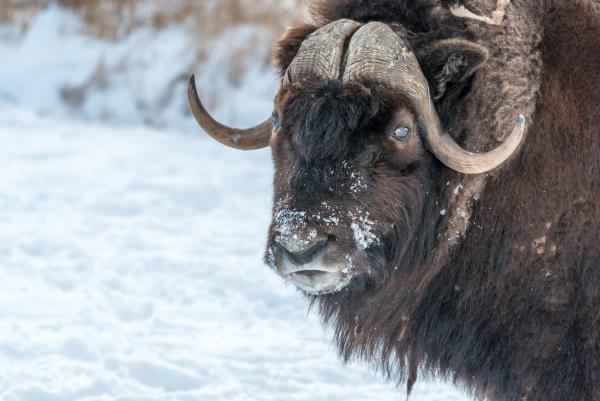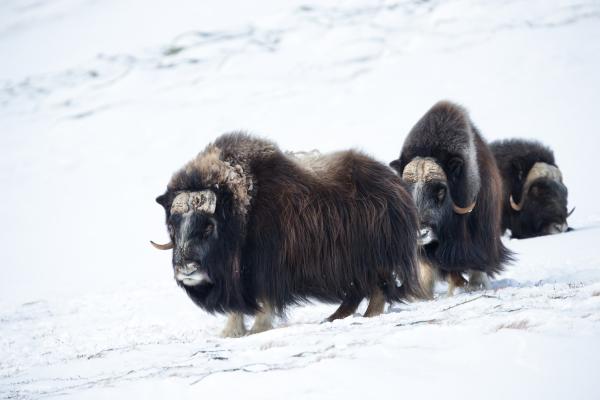The musk ox (scientific name: Ovibos moschatus) is one of the most iconic large mammals of the Arctic tundra. With its massive body, broad head, and striking curved horns, it resembles a bison or buffalo at first glance. However, genetically, the musk ox is more closely related to goats and sheep than to true cattle. This article offers an in-depth look at the musk ox's main features, distribution, feeding habits, behavioral adaptations, and reproductive strategies, helping you discover the secrets behind this legendary “Arctic giant.”

Robust Body: Adult musk oxen stand about 1.2 meters tall at the shoulder, with broad heads and strong, curved horns found in both males and females. The males’ horn bases are especially thick and prominent.
Extreme Cold Adaptation: Covered in long, dense hair—especially the underlayer called qiviut, the world’s warmest natural fiber—musk oxen are perfectly adapted to withstand temperatures as low as -40°C.
Distinct Scent: The name “musk ox” comes from the strong, musky odor males release via urine during mating season to attract females.
Compact Features: With a barrel-shaped torso, short legs and tail, and a wide, muscular back, musk oxen are built for life in the harsh Arctic.
Musk oxen are found primarily in the high Arctic regions of the Northern Hemisphere, including Greenland, northern Canada, and Alaska. Humans have also reintroduced them to Siberia, Russia, and parts of Norway.
Classic Habitat: Arctic tundra regions dominated by moss, lichens, low shrubs, and grasses.
Environmental Adaptations: Their thick fur and highly efficient metabolism help them maintain a core body temperature of 38°C, even in severe cold. Their wide hooves spread their weight across snow and ice, preventing them from sinking or losing heat.

Musk oxen are ruminants with a four-chambered stomach, making them excellent at digesting fibrous Arctic vegetation. Their diet includes:
Primary Foods: Grasses, sedges, mosses, lichens, willow (Salix richardsonii), and wild legumes (Oxytropis spp.).
Feeding Habits: An adult musk ox can consume around 5 kilograms of plant matter daily. They increase food intake during the late summer and fall to build up fat reserves for winter.
Seasonal Diet: During winter, when food is scarce, they dig through snow for moss and woody plants.
Group Defense: When threatened by predators (such as wolves), musk oxen form a defensive circle, with adults facing outward and calves in the center.
“Standing Hibernation”: In extreme cold, they minimize movement and stand still for long periods to conserve energy—a behavior sometimes called “standing hibernation.”
Migration and Movement: Musk oxen often travel in single-file lines through deep snow, allowing those behind to save energy as the lead individuals clear a path.
Wind Protection: During Arctic storms, musk oxen huddle together with their backs to the wind, and dominant males take the brunt of exposure to protect the group.

Sexual Maturity: Musk oxen reach sexual maturity at about 8 months, though most breed for the first time at 2–3 years old.
Breeding Season: The rut occurs from late summer to early autumn. Males engage in fierce head-butting battles for dominance and the right to form harems.
Gestation and Calving: Gestation lasts around 8 months, with calves born in spring. Each female typically has one calf per year, born covered in warm, insulating fur.
Mother-Calf Bond: Calves stay close to their mothers and shelter beneath her long fur for warmth, becoming independent after about a year.
Lifespan: In the wild, musk oxen can live 15–20 years, but early mortality often occurs due to predation or accidents such as breaking through ice.
Musk oxen play a vital role in Arctic tundra ecosystems as major herbivores, influencing plant communities and serving as prey for top predators. Overhunting once threatened their survival, but conservation and reintroduction efforts have led to a strong recovery in many regions.

Conclusion
The musk ox, with its long hair and robust physique, stands as a true survivor of the Arctic tundra. Understanding its habitat, diet, and life cycle provides key insights into the adaptability and ecological importance of this remarkable species.
Bibliography
Elder, S. (2005) "Ovibos moschatus" Available at: https://animaldiversity.org/accounts/Ovibos_moschatus/
Lopez, B. (2020) Arctic Dreams. Madrid: Editorial Capital Swing.
animal tags: Muskox
We created this article in conjunction with AI technology, then made sure it was fact-checked and edited by a Animals Top editor.